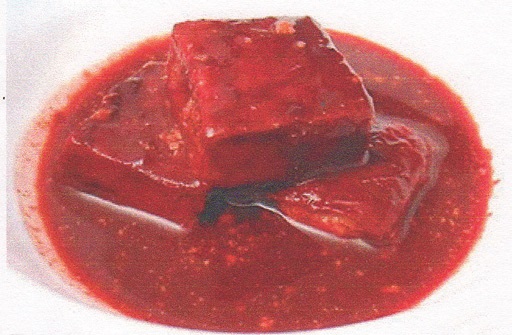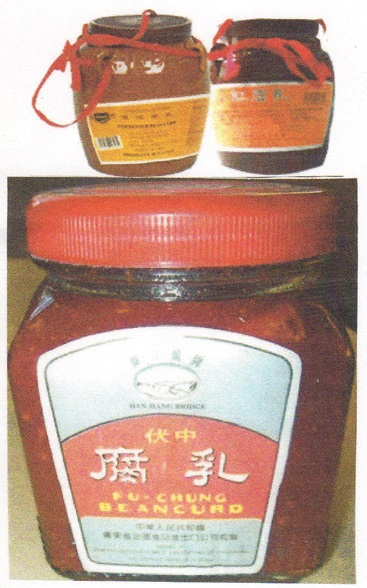
| What is Flavor and Fortune? |
| How do I subscribe? |
| How do I get past issues? |
| How do I advertise? |
| How do I contact the editor? |
Read 13145307 times
Connect me to:
| Home |
| Articles |
| Book reviews |
| Letters to the Editor |
| Newmans News and Notes |
| Recipes |
| Restaurant reviews |
| Article Index (all years, slow) |
| List of Article Years |
| Article Index (2026) |
| Article Index (last 2 years) |
| Things others say |
| Related Links |
| Log In... |
| Authors |
| Categories & Topics |
Fermented Red Doufu
| by Jacqueline M. Newman |
Sauces, Seasonings, and Spices
Fall Volume: 2018 Issue: 25(3) pages: 7 to 11
Soybeans, are one of the five staple grains of ancient China. They are used to make bean curd which the Chinese call doufu, which is made from soy beans, water, and a coagulant. Red doufu needs a starter, a colorant, and a mold to work. This becomes a flavor enhancer the Chinese love: doufu nai.
One story of how it originated is it took place at a teahouse. There, a bean curd seller stopped to watch a game of chess. Hours later when he went to get his basket, he discovered his coagulated bean curd had gone moldy. Thinking the two immortals he chatted with played a trick on him, he surmised they might be the ones responsible for the change in his bean curd. He then decided to confront them.



Sympathetic but not guilty, they assured him they did not do that. They told him to go home and marinate the moldy stuff with salt, spices, and cold water so it would go back to becoming what it originally was. Not believing but hoping against hope, he did as instructed. Because he was exhausted, he immediately went to bed. The next morning his bean curd was different, even better. It was aromatic and red, and tasted better than before.
The next time he made bean curd, he did repeat this with his ordinary bean curd as he was told to. It did produce the same great aromatic red doufu of that first batch. He gave it to many friends and all agreed it tasted great. They loved his new product called doufu nei.
During the Song Dynasty, Zhu Xi reported this red bean curd was not new. He wrote that years before it was so prepared by the Prince of Huainan (179 - 122 BCE) Others did agree that it was neither new nor original. Truth be told, no one really knows where, how, or when it began.
In a chapter in the ‘Economic Affairs of the Shih Chi’ or The Historical Records Book, it was called ‘mold ferment’. Elsewhere, it was reported as ‘salty fermented red soybeans’ or ‘preserved doufu’ Some, in English, call it ‘red tofu cheese.’ During the Qing Dynasty, around 1641, Wang Su-hsiung referred to it in the Food Encyclopedia as ‘superior’ bean curd calling it more beneficial than ‘firm bean curd, and better than other kinds of doufu.
This endorsement did help it become more popular than other renditions. Some say it was developed in the Henan Province. Some was found in ‘Tomb No. 1. carved in stone there; still not everyone does agree. Later, folks did see the carving depicted in an 1982 Agricutural Archeology volume where two people stand in front of a large basin near a rotary stone mill. They are holding a cloth in front of it and it does look like they are draining bean curd solids from liquid. Still, many refuse to believe it is as old as this carving indicates.
Some conjecture it could be made more recently with nigari or Epson salts, both trade products, or with alum, vinegar, lemon juice, or a mixture of them. We now know it as a coagulated fermented food. In Spring it takes five days, needs eight in Winter. We also know this moldy material dries in the sun after it is marinated in salt with or without an alcoholic liquid and spices. We also know it becomes red fermented doufu when made with red rice. Folks know it is easy to digest, has lots of B vitamins, calcium, phosphorus, iron, and other nutrients, and that it is low in calories, its overall nutrient profile close to that of many milks, cow milk included. Chinese TCM practitioners tell us it benefits the lungs and large intestines, moistens dry conditions, relieves oral and stomach inflammations, neutralizes toxins, and heals many less than healthy bodily reactions. They also say that when mashed, it is a fine poultice, adds contrast to pungent, salty, baked, steamed, boiled, broiled, deep-fried, sauteed, and raw foods, and that most Chinese adore it.
Carved in stone, first found in the 1940s and then dated as made in the Eastern Han Dynasty (25 - 20CE) historians believe it shows fermented bean curd available in Chinese markets that was made with ground regular, long or short red rice. Nowadays, anyone can purchase it made with chilli peppers, fermented or not. Perhaps it was also made in homes then and was quite salty. Do purchase some, keep it refrigerated until using it, and do store it in a covered glass container until you do. Asian markets sell different kinds with many spices or seasonings or none. It is shown on the cover of this issue and with this article on page 7. It does a fine job enhancing many different dishes, and is made mostly using ground soy beans, though there are some made with taro or other beans or other foods. Most are inoculated with bacteria or fungi spores before it ferments. Some call it tou ci or sufu, others do not indicate its main ingredient source. We buy ours most often made from soy beans or taro, and like it mixed with wine, sesame oil, vinegar, spices, and/red rice yeast. Some use Monascus purpureuc or another colorant or coagulant. Some old cookbooks say it can have high levels of a toxin or citrinin. Hopefully, most no longer do. If you make your own, you can color it with cranberry or another red juice.
Years ago, some sources said soy beans were inferior grains. We now know this to be untrue. In ancient times some did say they are hazardous to your health; that is also not true. In the Discourse on Nurturing Life book it does say ingesting soybeans makes one feel heavy. But that is not ill health. It may be a source of feeling bloated. That may be why they say that. Soy beans are a Chinese staple and a good source of protein. They can grow on land depleted of nutrients and produce good yields even in poor years. The Chinese love them and have eaten them for generations with no ill effects.
Raw soy beans are difficult to digest as their complex carbohydrate components such as raffinose stachyose, and alpha-galactosides do not hydrolyze with digestive enzymes in the gut. This can lead to flatulence for many folk, not ill health. Some say, they taste unpleasant and have a beany after taste. Many early Chinese worked to convert soy beans to processed foods making them into fermented doufu.
Below are several recipes using fermented doufu. Not well known nor popular in western cuisines, one can find many kinds in Asian markets. The recipes that follow can be made with white or red fermented doufu, and we do love both. They enhance the flavors of many dishes, and we suggest you try them in lots of them.
| Hot and Sour Meatball Soup |
|---|
3 one-inch pieces fresh peeled ginger, minced
1. In a blender, pulse ginger and garlic coarsely.
|
| Hakka Taro |
|---|
¼ cup vegetable oil
1. Heat a wok or fry pan, add the oil, then fry the taro
slices on both sides until a light tan, then remove and
drain them on paper towels.
|
| Water Convolvulus and Bean Curd |
|---|
1 pound water convolvulus
1. Rinse water convolvulus and cut into two- to three-inch pieces.
|
| Cabbage and Fermented Bean Curd |
|---|
3 Tablespoons vegetable oil
1. Heat wok or fry pan, add the oil, then stir-fry the
sugar, ginger, garlic, dried shrimps, mashed bean curd
and soy bean paste for one minute before adding the
mushroom pieces.
|
| Suzhou Pork and Fermented Doufu |
|---|
½ pound lean pork belly with its skin, cubed into two-inch pieces
1. Put pork belly pieces in two cups of boiling water in a
small pot then simmer for two minutes and then drain
discarding the water.
|
| Braised Pork Ribs |
|---|
2 pounds pork ribs separated and cut into two-inch pieces
1. Put ribs in large pot of boiling water for two minutes,
then put them under cold running water for two more
minutes and then drain them. Let them air dry on paper
towels for one hour.
|
| Pork Belly, Taro, and Bean Curd |
|---|
3 leaves cabbage
1. In a large pot, add the lettuce or cabbage leaves and
stir well before adding the pork belly and all other
ingredients. Then cover with one cup of cold water.
Simmer them covered for one hour.
|
| Roast Duck in Fermented Doufu |
|---|
¼ pound soft white bean curd, mashed
1. Mix all ingredients except the duck tossing them well,
and then cover them with plastic wrap and refrigerate
overnight or for at least four hours.
|
| Vegetarian Lion's Head |
|---|
1 pound soft bean curd, liquid discarded, cut into small cubes and mashed
1. Put mashed soft and red bean curd in a bowl and mix well.
|
| Steamed Pork in Lotus Leaf |
|---|
5 Tablespoons raw rice
1. In a dry wok or fry pan, roast the rice stirring
often, until brown and aromatic. Then crush it
with the handle of the cleaver.
|
| Vegetables in Fermented Sauce |
|---|
3 Tablespoons dark soy sauce
1. Mix soy sauce, rice wine, sugar, cornstarch,
broth, and half a cup of water and set this aside.
|

Copyright © 1994-2026 by ISACC, all rights reserved
Address
3 Jefferson Ferry Drive
S. Setauket NY 11720